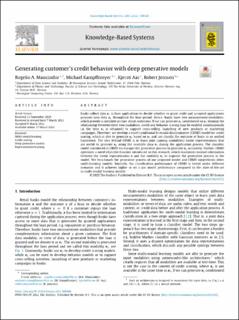| dc.contributor.author | Andrade Mancisidor, Rogelio | |
| dc.contributor.author | Kampffmeyer, Michael | |
| dc.contributor.author | Aas, Kjersti | |
| dc.contributor.author | Jenssen, Robert | |
| dc.date.accessioned | 2022-08-05T07:40:49Z | |
| dc.date.available | 2022-08-05T07:40:49Z | |
| dc.date.created | 2022-04-28T16:53:06Z | |
| dc.date.issued | 2022 | |
| dc.identifier.citation | Knowledge-Based Systems. 2022, 245 1-13. | en_US |
| dc.identifier.issn | 0950-7051 | |
| dc.identifier.uri | https://hdl.handle.net/11250/3010243 | |
| dc.description.abstract | Innovation is considered essential for today's organizations to survive and thrive. Researchers have also stressed the importance of leadership as a driver of followers' innovative work behavior (FIB). Yet, despite a large amount of research, three areas remain understudied: (a) The relative importance of different forms of leadership for FIB; (b) the mechanisms through which leadership impacts FIB; and (c) the degree to which relationships between leadership and FIB are generalizable across cultures. To address these lacunae, we propose an integrated model connecting four types of positive leadership behaviors, two types of identification (as mediating variables), and FIB. We tested our model in a global data set comprising responses of N = 7,225 participants from 23 countries, grouped into nine cultural clusters. Our results indicate that perceived LMX quality was the strongest relative predictor of FIB. Furthermore, the relationships between both perceived LMX quality and identity leadership with FIB were mediated by social identification. The indirect effect of LMX on FIB via social identification was stable across clusters, whereas the indirect effects of the other forms of leadership on FIB via social identification were stronger in countries high versus low on collectivism. Power distance did not influence the relations. | en_US |
| dc.language.iso | eng | en_US |
| dc.publisher | Elsevier | en_US |
| dc.rights | Navngivelse 4.0 Internasjonal | * |
| dc.rights.uri | http://creativecommons.org/licenses/by/4.0/deed.no | * |
| dc.subject | Multi-modal learning | en_US |
| dc.subject | Credit scoring | en_US |
| dc.subject | Deep generative models | en_US |
| dc.subject | Representation learning | en_US |
| dc.title | Generating customer's credit behavior with deep generative models | en_US |
| dc.title.alternative | Generating customer's credit behavior with deep generative models | en_US |
| dc.type | Peer reviewed | en_US |
| dc.type | Journal article | en_US |
| dc.description.version | publishedVersion | en_US |
| dc.rights.holder | The Authors | en_US |
| dc.source.pagenumber | 1-13 | en_US |
| dc.source.volume | 245 | en_US |
| dc.source.journal | Knowledge-Based Systems | en_US |
| dc.identifier.doi | 10.1016/j.knosys.2022.108568 | |
| dc.identifier.cristin | 2019914 | |
| cristin.ispublished | true | |
| cristin.fulltext | original | |
| cristin.qualitycode | 2 | |

